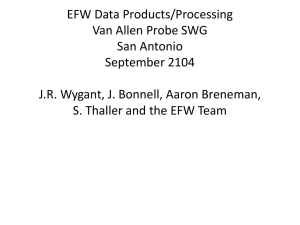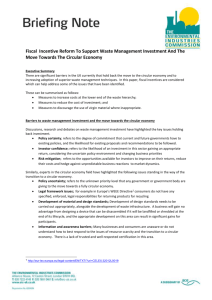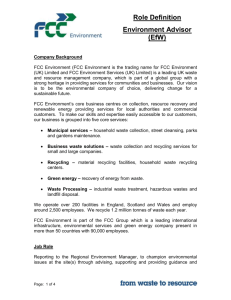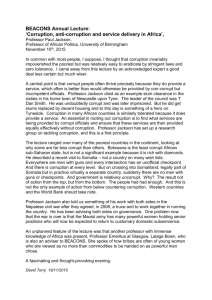Political Corruption as Rational Choice
advertisement
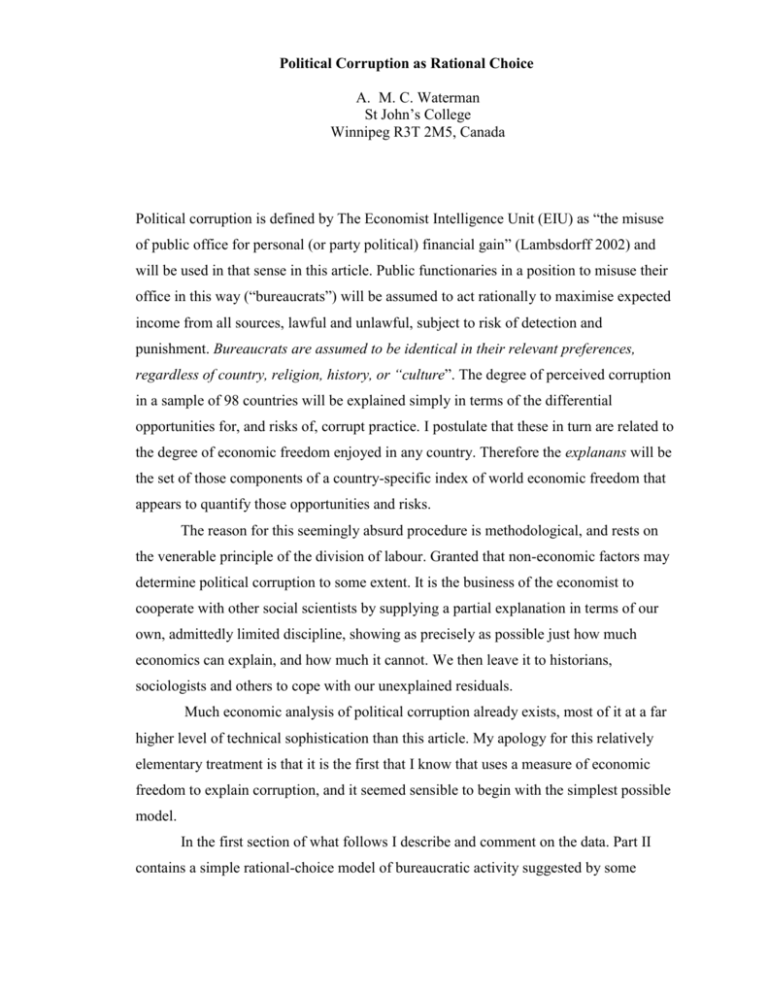
Political Corruption as Rational Choice A. M. C. Waterman St John’s College Winnipeg R3T 2M5, Canada Political corruption is defined by The Economist Intelligence Unit (EIU) as “the misuse of public office for personal (or party political) financial gain” (Lambsdorff 2002) and will be used in that sense in this article. Public functionaries in a position to misuse their office in this way (“bureaucrats”) will be assumed to act rationally to maximise expected income from all sources, lawful and unlawful, subject to risk of detection and punishment. Bureaucrats are assumed to be identical in their relevant preferences, regardless of country, religion, history, or “culture”. The degree of perceived corruption in a sample of 98 countries will be explained simply in terms of the differential opportunities for, and risks of, corrupt practice. I postulate that these in turn are related to the degree of economic freedom enjoyed in any country. Therefore the explanans will be the set of those components of a country-specific index of world economic freedom that appears to quantify those opportunities and risks. The reason for this seemingly absurd procedure is methodological, and rests on the venerable principle of the division of labour. Granted that non-economic factors may determine political corruption to some extent. It is the business of the economist to cooperate with other social scientists by supplying a partial explanation in terms of our own, admittedly limited discipline, showing as precisely as possible just how much economics can explain, and how much it cannot. We then leave it to historians, sociologists and others to cope with our unexplained residuals. Much economic analysis of political corruption already exists, most of it at a far higher level of technical sophistication than this article. My apology for this relatively elementary treatment is that it is the first that I know that uses a measure of economic freedom to explain corruption, and it seemed sensible to begin with the simplest possible model. In the first section of what follows I describe and comment on the data. Part II contains a simple rational-choice model of bureaucratic activity suggested by some 2 oddities in those data. The results of an econometric test of the model are presented in Part III, and a discussion of those results in Part IV. I Transparency International (http://www.transparency.org/about_ti/index.html) publishes an annual set of perceived corruption indices (CPI) which measures the “cleanness” or freedom from corruption of countries on a scale of 0.0 (utterly corrupt) to 10.0 (perfectly clean). The latest set of indices (2002) ranks 102 countries from Bangladesh (1.2) to Finland (9.7). CPI for 2002 is a weighted average of the results of 15 surveys undertaken respectively by Columbia University, Public and Executive Risk Consultancy of Hong Kong (two surveys), Institute for Management Development of Switzerland (three surveys), the World Bank, PricewaterhouseCoopers, the EIU, Freedom House of the USA, the World Economic Forum (four surveys), and Gallup International. These surveys were conducted in any or all of 2000, 2001 and 2002. Those surveyed were variously academic and diplomatic “country-experts”, expatriate and local business executives, CFOs, bankers and equity analysts, domestic and international business corporations. Surveys covered as few as 14 countries and as many as 121. Questions were variations on the theme of “assessment of the pervasiveness of corruption” (EIU), including “frequency of bribing”, “undocumented extra payments” for licences and permits, and the “costs associated with such payments for doing business”. A “Background Paper” (Lambsdorff 2002) considers sources of bias in the surveys and argues that these are mutually offsetting (pp. 4-6); describes the standardizing and weighting procedures (pp. 6-8); considers the reliability of the index in terms of the high rank correlations provided by the various surveys (pp. 8-9); and attempts to measure a 90% confidence range for the index (pp. 10-12). In some cases standardized results of the several surveys reveal a comforting agreement. Canada, for example, has a CPI of 9.0 based on 10 surveys, the standardized scores of which range from 8.7 to 9.3 with a standard deviation of 0.2. Namibia, however, has a CPI of 5.7 based on 5 surveys that ranks it just below Slovenia and just 3 above Taiwan in cleanness. But the survey scores range from 3.6 (as corrupt as Mexico) to 8.9 (purer than the UK or Norway) with a standard deviation of 2.2. In general, perceptions of corruption are more convergent for advanced, capitalist countries, for all of which save Italy (11 surveys, standard deviation 1.1) the standard deviation is 1.0 or less. The most disagreement exists for Namibia, Botswana (5 surveys, standard deviation 1.5), Trinidad and Tobago (4 surveys, standard deviation 1.5), and Ghana (4 surveys, standard deviation 1.4). It it obvious to an economist that the more economic freedom in any country, the less opportunity in general for bureaucrats to misuse their public office for personal (or party-political) financial gain. It therefore seemed fruitful to confront the CPI scores with corresponding country-specific indices of economic freedom (EFW) compiled and published annually by the Economic Freedom Network. The latest annual publication provides indices for 2001 (Gwartney and Lawson, 2003), which are therefore closely comparable with the latest CPI based on observations in 2000, 2001 and 2002. As with CPI, EFW measures countries on a scale of 0.0 to 10.0, where 0.0 signifies a virtual absence of economic freedom and 10.0 signifies complete economic freedom. In 2003, EFW scores were published for 123 countries, ranging from Myanmar (3.8) to Hong Kong (8.6). By counting all countries for which both CPI and EFW indices exist, and by applying EFW scores for Russia to Azerbaijan, Belarus, Moldova, Georgia, Kazakhstan and Uzbekistan (for which CPI but not EFW exist), a sample of 99 countries was obtained. CPI indices and the major components of the EFW indices for these 99 comprise the data set of this study, printed in Appendix 1. A preliminary investigation revealed that CPI score was correlated with EFW score for the whole sample with an R-squared of 0.57. CPI rank was correlated with EFW rank with an R-squared of 0.59. But when deviations were measured of actual CPI from CPI predicted by the simple regression some interesting anomalies appeared. A number of countries with high economic freedom (as measured by EFW) were among the most corrupt. Table 1 shows EFW and CPI scores for six of these. Closer inspection of the EFW indices threw light on these anomalies and suggested the hypothesis formalised in Part II and tested in Part III. 4 Table 1 ‘Economic Freedom’ and Perceived Corruption in Six Countries, 2002 EFW actual Argentina El Salvador Dominican Republic Haiti Guatemala 7.2 7.2 6.7 6.5 6.3 2.8 3.4 3.5 2.2 2.5 CPI____________ deviation from predicted -3.0 -2.4 -0.8 -2.5 -1.8 Now EFW indices are the unweighted arithmetic means of five sub-indices, each measuring the degree of (putative) economic freedom in one “area”: EFW(1) Size of government: expenditures, taxes and enterprises; EFW(2) Legal structure and security of property rights; EFW(3) Access to sound money; EFW(4) Freedom to exchange with foreigners; and EFW(5) Regulation of credit, labour and business. Each of these subindices in turn is the unweighted arithmetic mean of a number of component indices, in the case of EFW(5) for example, EFW(5A) credit market regulations, EFW(5B) labour market regulations and EFW(5C) business regulations. Finally, each of these sub-indices is the unweighted arithmetic mean of a number of components. In the example of EFW(5A), measures of the percentage of all deposits held in privately-owned banks, of the extent of foreign competition for domestic banks, of the percentage of bank credit extended to private sector, and of the extent to which domestic interest rates are freely determined in the market and not subjected to controls (Gwartney and Lawson 2003, pp. 24-32). In general, these components of EFW are noticeably correlated with one another. But this is not the case with EFW(1) as Table 2 reveals. Measures of ‘size of government’ are actually negatively correlated with those of ‘legal structure and security of property rights’ and of ‘freedom to exchange with foreigners’; and seemingly unrelated to those of ‘sound money’ and ‘regulation of credit, labour and business’. 5 Table 2 Correlation Matrix of the Five ‘Areas’ of EFW EFW(1) EFW(2) EFW(1) EFW(2) EFW(3) EFW(4) EFW(5) 1.0000 -0.3490 0.0724 -0.0119 0.0616 1.0000 0.5690 0.6019 0.6676 1.0000 0.5033 0.5918 1.0000 0.4079 EFW(3) EFW(4) EFW(5) 1.0000 A preliminary, merely statistical explanation of the anomaly is now apparent. The six ‘free’ but ‘corrupt’ countries in Table 1 have small government and therefore high EFW(1) scores, which raises the average EFW despite very low scores on EFW(2) and only moderate scores in the other three ‘areas’. This suggests that ‘size of government’ may actually have a small, or possibly even a negative, effect on cleanness. Table 3 reports further evidence for this view. Table 3 Simple Regression of CPI on Each of the “Areas” of EFW Constant Coefficient R-squared EFW(1) 7.17 -0.43 0.07 EFW(1AB) 9.86 -0.80 0.41 EFW(2) -1.36 1.06 0.81 EFW(3) -0.81 0.69 0.32 EFW(4) -6.65 1.55 0.42 EFW(5) -5.95 1.84 0.47 6 CPI is negatively related to EFW(1) but the R-squared is negligible. However, when only the first two sub-indices, of EFW(1) are considered, (A) government consumption and (B) transfers and subsidies, the average of these is strongly but negatively correlated with CPI. The remaining components are positively correlated with CPI as we might expect, especially EFW(2) which measures the efficacy of the legal structure and the security of property rights. From these preliminary results it would seem worthwhile to construct and test a model in which size of government, at any rate as measured by the first two components of EFW(1), is predicted to have a negative effect on perceived corruption. The hypothesis rests upon the assumption that the larger the relative size of the government sector, the greater the opportunity presented to bureaucrats of lawful, safe and financially rewarding, employment in their proper offices; and the smaller the temptation, therefore, to divert some of their employers’ time and other resources into unavoidably risky corrupt practice. Consider the example of Sweden, which has a CPI of 9.3 and is the sixth cleanest country in the world. Yet its EFW(1) is only 3.0, ranking it 119th out of 123 on this scale, with one of the largest government sectors in the sample. Its EFW(2) score is 8.6 (13th) and the average of EFW(4) and (5) is 7.2: the rule of law is very strong, and the degree of regulation of foreign and domestic transactions fairly small. In Sweden a large and important government affords high-status, high-paying employment to an elite; rigorous enforcement of the law raises the cost of corrupt practice to dangerous levels; and a low level of economic regulation affords relatively few opportunities, even risky opportunities, for supplementing salary with bribes. II Assume that all bureaucrats are alike, that they wish to maximize expected income from all sources, and that they are indifferent as to source. Assume that the sources of income are two: E, expected income from lawful employment as public servants and C, expected income from corrupt practice. They seek to allocate their working time such that the proportion, 0 ≤ b ≤ 1, spent in corrupt practice maximizes total expected income, y=E+C (1) 7 Expected income from lawful employment, E = (1 – p).E(G) (2) where p is the probability of being dismissed for misallocating paid time, E(G) the income in dollars available from regular employment, and G is a country-specific index of the relative size of the public sector, 0 ≤ G ≤ 1, E(0) = 0 and E' > 0. The probability, p = p(b), p' > 0, p(0) = 0, p(1) = 1. Assume for simplicity that the second derivative of p is zero, hence p = b. Expected income in dollars from corrupt practice, C = (1 – π).C(R, b) (3) where π is the probability of detection and punishment, R is a country-specific index of the degree of regulation of the economy, 0 ≤ R ≤ 1, and C1 > 0, C2 > 0. Probability of detection and punishment depends both upon b and also upon L, 0 ≤ L ≤ 1, a countryspecific index of the fairness and certainty with which the law is administered and property rights protected. Let π = π(b, L), where π1 > 0, π2 > 0, π(0, L) = π(b, 0) = 0, and π(1, 1) = 1. Assume for simplicity that π11 = π22 = 0, hence π = b.L. Assume further for the sake of simplicity that C(R, b) can be approximated as C = bR, where the index R is now measured in dollars of possible income from corrupt practice. The expected income from corrupt practice is now written as C = (1 –bL).bR = bR – b2LR (4) Thus total expected income is y = (1 –b).E(G) + bR – b2LR (5) and it is this that bureaucrats seek to maximize by choosing the most profitable allocation of their time between lawful employment and corrupt practice. Define the ratio, x ≡ E(G)/R. Then by partial differentiation of (5) with respect to b, ∂y/∂b = R(1 – x – 2bL) (6) = 0 when (1 – x) = 2bL ∂2y/∂b2 = – 2RL < 0 (6A) Hence a maximum value of y exists for x ≤ 1 where the optimum value of b > 0, b* = (1 – x)/2L (7) 8 [Note that because b* cannot be greater than unity, any value of L < (1 – x)/2 can have no further effect on corrupt practice. Similarly, because L has a maximum value of unity, b* cannot be reduced below (1 – x)/2 by improvement in the administration of justice.] When bureaucrats allocate their time so as to maximize total expected income, their expected income from corrupt practices, C* = R.(1 – x2)/4L (8) > 0 if |x| < 1 Note that x = x(G, R), x1 > 0, x2 < 0. Hence by substitution of x(G, R) for x in (8) and partial differentiation with respect to R, G and L respectively, we obtain: ∂C*/∂R = [(1 – x2) – 2x.x2R]/4L > 0 if |x| < 1 (9) ∂C*/∂G = – 2x.x1.R/4L < 0 if x > 0 (10) ∂C*/∂L = – (1 – x2)R/4L2 < 0 if |x| < 1 (11) It is evident from (8), (9), (10) and (11) that given the assumption that E' > 0, the ratio x is crucial in determining the rationality of corrupt practice. For if 0 ≤ [x ≡ E(G)/R] < 1, some income may be expected from corrupt practice; and that expected income will be an increasing function of the country-specific index of regulation, R, and decreasing functions of the country-specific indices of relative government size, G, and law-enforcement, L. But if x ≥ 1, C* = O and E* = E(G); which is to say that corrupt practice is never rational. Moreover, if x ≥ 1, then ∂C*/∂L = 0, and the negative sign of ∂C*/∂G is meaningless. Only the positive sign of ∂C*/∂R may have economic meaning, since an increase in R relative to E(G), by increasing x, moves the ratio of these parameters nearer to that value at which corrupt practice becomes rational. Maximum total expected income, y* = E* + C* is obtained by substituting (7) for b* into (5) for y. Thus, y* = R[ x + (1 – x)2/4L] (12) The response of this magnitude to changes in the parameters is ambiguous, and depends on the relative size of the index L and the ratio x. ∂y*/∂R = [1 – (1 – x)/2L].x2 < 0 if L > (1 – x)/2 and 0≤ x ≤1 = 0 if L = (1 – x)/2 and 0≤ x ≤1 (13) 9 > 0 if L < (1 – x)/2 and 0≤ x≤1 The third possibility is ruled out because it implies that b* exceeds unity, as explained above. By similar reasoning, ∂y*/∂G = [1 – (1 – x)/2L].x1 (14) ≥ 0 as L ≥ 1 – x)/2 and 0≤ x≤ 1 ∂y*/∂L = – (1 – x2)R/4L2 ≤ 0 as |x| < 1 (15) An increase in the degree of regulation, R, increases C* but by increasing the ratio x and making corrupt practice relatively more attractive, reduces E* more than correspondingly. An increase in relative size of government, G, has the opposite effect. An increase in the index of law-enforcement, L, always reduces y* since it reduces C* without increasing E*. The indices G, L and R correspond to – and may provisionally be regarded as transformations of – three components of the country-specific EFW index of “economic freedom” where EFW(1) = 10(1 – G), EFW(2) = 10L and EFW(5) = 10(1 – R). Any of C*, C*/E* or b* might serve as indicators of perceptible (and hence perceived) corruption. Because when b* = 0, C* = 0 and E* is maximal, and because when b* = 1, E* = 0 and all income (if any) comes from corrupt practice, it appears that b* would be a suitable indicator of perceptible corruption, having the convenient property of a range from 0 to 1. Assuming that CPI = 10(1 – b*), we may investigate the predicted effect upon perceived corruption of a change in the parameters in the usual way: ∂b*/∂R = x/2LR > 0 (16) ∂b*/∂G = – E'/2LR < 0 (17) ∂b*/∂L = – (1 – x)/2L2 < 0 if x < 1 (18) An increase in the degree of regulation increases predicted perceived corruption; an increase in the relative size of government reduces predicted perceived corruption, and an increase in law enforcement reduces predicted perceived corruption. Since CPI = 10(1– b*) and EFW(5) = 10(1 – R), ∂CPI/∂EFW(5) > 0 (16A) Since EFW(1) = 10(1 – G), ∂CPI/∂EFW(1) < 0 (17A) 10 And since EFW(2) = 10L, ∂CPI/∂EFW(2) > 0 (18A) It may be noted that the same signs would be obtained for the partial derivatives of CPI with respect to EFW (1), (2) and (5) had either of C* or C*/E* been employed as proxies for CPI. It therefore seems allowable, or at any rate excusable, to test a simple linear hypothesis: CPI = C + α.EFW(1) + β.EFW(2) + γ.EFW(5); α < 0, β > 0, γ > 0 (19) Where EFW(1), (2) and (5) are proxies for G, L and R respectively. III Least-squares multiple regression of CPI on EFW(1), EFW(2) and EFW(5), as in (19), gave values of C = -3.0758, α. = +0.0092, β = +0.9445 and γ = +0.4010, with an adjusted R-squared of 0.8216. The coefficient of EFW(1) was not significantly different from zero. It will be recalled from Table 3 above that a simple correlation of CPI on EFW(1) was similarly inconclusive, but that a more interesting result was obtained by considering only the first two sub-indices. The justification for this seemingly arbitrary mutilation of the data must now be considered. EFW(1) is an average of sub-indices measuring (A) general government consumption as a percentage of total consumption, (B) transfers and subsidies as a percentage of GDP, (C) government enterprises and investment as a percentage of GDP, and (D) top marginal tax rate (and income threshold to which it applies), i. excluding applicable payroll taxes, and ii. including applicable payroll taxes. There seemed to be little obvious connexion between (D) and the opportunities for bureaucrats to engage in lawful and financially rewarding labour in their official function. The same is true of (C) when it is recognised that bureaucrats who may misuse their office for financial gain, and managers of state enterprises, are different subsets of all public-sector employees. The latter have little if any discretionary power over such matters as licenses and permits, and are more likely to be watched by supervisors ambitious for the satisfactory performance of their unit. Whether state enterprises are few or many, the argument G of the E-function 11 in (2) above seems unlikely to be much affected. On the basis of these conclusions it was decided to replace EFW(1) in the regression with EFW(1AB). Table 3 shows that EFW(3), access to sound money, and EFW(4) freedom to exchange with foreigners, were each definitely correlated with CPI. EFW(3) is the average of (A) average annual growth of the money supply in the last five years minus average annual growth of real GDP in the last ten years, (B) standard inflation variability in the last five years, (C) recent inflation rate, and (D) freedom to own foreign currency bank accounts domestically and abroad. Save perhaps for (D) there seems little in any of this that would put much power in the hands of ordinary bureaucrats. But this is evidently not the case of EFW(4): the average of (A) taxes on international trade, (B) regulatory trade barriers, (C) actual size of trade sector compared to expected size, (D) difference between official exchange rate and black market rate, and (E) international capital market controls. Rich opportunities for corruption reside in most of these, particularly in such sub-sub-indices as those of ‘hidden import barriers’, ‘time required for administrative red tape’ and ‘restrictions on the freedom of citizens to engage in capital market exchange with foreigners’. Though Transparency International reports that ‘domestic companies’ are more likely to bribe domestic bureaucrats than are any non-resident corporation, a high propensity to bribe was reported by companies from Russia, China, Taiwan, South Korea, Italy, Hong Kong, Malaysia, Japan, the USA, France and Spain (International Bribe Payers Index 2002, http://www.transparency.org/cpi/2002/bpi2002.en.html). It was therefore decided to include EFW(4) in the study by averaging it with EFW(5), the combined index, EFW(45), appearing to be the best proxy for the variable R. Because estimates of EFW(1AB) were not available for twelve countries (Hong Kong, Japan, Trinidad and Tobago, Ghana, China, Ethiopia, Malawi, Honduras, Tanzania, Vietnam, Angola, Nigeria) these were excluded from the sample, which was thus based on 90 observations. The revised regression is: CPI = - 3.1386 - 0.1453.EFW(1AB) + 0.7762.EFW(2) + 0.6636.EFW(45) std error 1.1687 0.0694 0.0929 0.2057 t-statistic -2.6856 -2.0938 8.3541 3.2262 12 prob. 0.0087 0.0392 0.0000 0.0018 with an adjusted R-squared of 0.8429. The t-statistics confirm that all signs are significant at the 5% level, and the probability statistics that all magnitudes are significant at that level at least. The negative coefficient of EFW(1AB) confirms the hypothesis that perceived corruption is negatively related to size of government; and the adjusted Rsquared allows us to pretend that the rational choice model presented in part II above can explain 84% of political corruption in the years 2000, 2001 and 2002 -- to extent that this is accurately measured by the Corruption Perceptions Index. The constant term C = -3.1386 may suggest that if there ever were a country unfortunate enough to have the largest possible public sector, zero protection of property rights, total absence of law enforcement, and total regulation of all domestic and foreign economic activity, it would have a CPI of -3.1, 4.3 points below Bangladesh, the most corrupt nation on earth. But this magnitude is more likely to be simply a measure of ignorance. The regression equation permits us to see how far my rational choice model is able to explain corruption in each country. Table 4 shows the deviation of actual CPI from the value predicted by the regression, with countries ranked in descending order of deviation. Standard deviation of the actual from predicted CPI is 0.936. Those 18 countries with a positive deviation of more than one standard deviation unit have been arbitrary classified as “relatively incorrupt”’; the 59 with deviations of less than one SD unit either way are classed as “predictably corrupt”; the 13 with negative deviations of more than one SD unit are classed as “relatively corrupt”. The data from which Table 4 is assembled are set out in full in Appendix 2. IV It is true, of course, that there exists an indefinitely large number of plausible theories, many of them congenial to economists, that could be tortured into giving up equation (19), complete with the proper signs of α, β, and γ. My model has not been confirmed. But it has survived discomfirmation, which is all we can hope for in any science. What then? 13 In the first place, my methodological minimalism serves – and was intended to serve -- a pedagogical, not to say a polemical, purpose. The model and the regression illustrate just how far we can go along strictly orthodox lines with considerably less technical equipment than is now expected of any undergraduate apprentice to our trade. Secondly, the statistically significant negative coefficient of EFW(1AB) cries out for attention. Even if my crude, economistic assumptions about bureaucratic behaviour are dismissed with angry contempt, the fact remains that one of the components of EFW is drastically unlike all the rest. Not only are its values uncorrelated, or negatively correlated, with those of all the other components. There can be no doubt that this particular element of ‘economic freedom’ has an opposite effect on perceived corruption to that of the others. Other things being equal, the bigger the government the less the corruption we perceive. Someone has to explain why. Those who construct the EFW index, and those who make use of it in studies of political corruption, should find this anomaly of considerable interest. Perhaps as important as the first two, the evidence of Table 4 throws some light on the question of how economists can collaborate with other social scientists in investigating the causes of political corruption. After the dull economic spadework has been done (and given the assumption that my study may be taken, for the time being, as having accomplished that spadework), there is plenty of more dignified labour remaining for historians, anthropologists, sociologists, political scientists and others. Britain, Slovenia, Brazil, Russia, Indonesia, Bulgaria, Paraguay, Bolivia, El Salvador, Sri Lanka, Botswana, Georgia, Malaysia and Belgium lie either on or very close to trend. The rational choice model predicts corruption in these countries with a high degree of accuracy. And 45 other countries have CPI scores that differ by less than one standard deviation from predicted values. But at one end of the scale Belarus, Chile, Iceland, Venezuela, Singapore, Sweden and Spain are (perceived as) far cleaner than they ought to be given the degree of regulation of their economies, the size of their governments, and the extent to which property rights are protected and laws enforced. And at the other end, Uganda, Kenya, Thailand, the Czech Republic and Zambia are seen as far more corrupt than they ought to be in light of these same factors. Conventional explanations in terms of 14 Table 4 Deviations of Actual from Predicted CPI in SD Units Relatively Incorrupt Countries (deviation ≥ +1.0) Belarus (+2.3), Chile (+2.0), Iceland (+1.8), Venezuela (+1.6), Singapore (+1.5), Sweden (+1.5), Spain (+1.5), New Zealand (+1.4), Norway (+1.4), Zimbabwe (+1.3), Finland (+1.3), Colombia (+1.3), Pakistan (+1.2), Guatemala (+1.2), Haiti (+1.1), Ecuador (+1.1), Luxembourg (+1.0), Mexico (+1.0) Predictably Corrupt Countries (-1.0 < deviation < +1.0) Switzerland (+0.9), Canada (+0.9), Denmark (+0.9), Dominican Republic (+0.9), Israel (+0.9), Peru (+0.9), Taiwan (+0.8), Senegal (+0.6), Uruguay (+0.6), Egypt (+0.6), Lithuania (+0.4), Australia (+0.4), Netherlands (+0.4), Côte d’Ivoire (+0.3), Turkey (+0.3), Argentina (+0.3), Uzbekistan (+0.3), United Kingdom (+0.2), Slovenia (+0.2), Brazil (+0.2), Russia (+0.1), Indonesia (+0.1), Bulgaria (+0.1), Paraguay (0.0), Bolivia (0.0), El Salvador (0.0), Sri Lanka (-0.1), Botswana (-0.2), Georgia (-0.2), Malaysia (0.2), Belgium (-0.2), Jamaica (-0.3), USA (-0.3), Austria (-0.3), South Korea (-0.3), Kazakhstan (-0.3), France (-0.3), Portugal (-0.4), Jordan (-0.4), Morocco (-0.4), Albania (-0.4), Philippines (-0.5), Bangladesh (-0.5), Nicaragua (-0.5), Greece (-0.5), Germany (0.6), Moldova (-0.6), Poland (-0.6), Tunisia (-0.6), Azerbaijan (-0.7), South Africa (-0.8), Estonia (-0.8), Mauritius (-0.8), Cameroon (-0.8), Croatia (-0.8), Madagascar (-0.9), Ukraine (-0.9), Romania (-0.9), Costa Rica (-0.9) Relatively Corrupt Countries (deviation ≤ -1.0) Ireland (-1.1), Namibia (-1.1), India (-1.1), Panama (-1.2), Italy (-1.2), Latvia (-1.3), Hungary (-1.4), Slovak Republic (-1.4), Uganda (-1.5), Kenya (-1.5), Thailand (-2.0), Czech Republic (-2.7), Zambia (-2.8) region, state of development, polity, and recent history are washed out by Table 4. In each of the three categories in that table there are countries from Europe, Africa, South East Asia and Latin America. In each there are advanced capitalist democracies, developing countries in the Third World, military dictatorships, and ‘transitional economies’. Nor does religion, and the culture created by long past history of a dominant religion, seem to have much effect. In each of the three categories are countries that might in some at least cultural sense be labelled ‘Roman Catholic’, ‘Eastern Orthodox’, ‘Protestant’, ‘Muslim’ and at least partially Hindu or Buddhist. Some of the deviation of actual from predicted CPI may result simply from measurement error in the data. It was noted in part I above that some countries, such as Namibia, have been assigned CPI scores on the basis of a very wide range of estimates. Table 5 reports actual and predicted CPI, and the range of those estimates that produced 15 Table 5 Actual and Predicted CPI, and Range of Survey Scores, for Seven Countries, 2002 CPI Chile Norway Haiti Mexico Ireland Namibia Italy Actual 7.5 8.5 2.2 3.6 6.9 5.7 5.2 Range of Survey Scores Predicted 5.6 7.2 1.1 2.7 7.9 6.8 6.4 5.6 – 8.8 6.9 – 9.3 0.8 – 4.0 2.5 – 4.9 5.5 – 8.1 3.6 – 8.9 3.4 – 7.2 the former, for those of the outliers in Table 4 for which predicted CPI falls within the range of the surveys used. It is at least possible, in some of these cases, that the regression results could be regarded as corrective of the surveys. In the extreme case of Namibia it is at least plausible to conjecture that the predicted score of 6.8 is as good or better than the average-of-survey score of 5.7. And in general the results must raise the suspicion that CPI may overstate the cleanness of Chile, Haiti, Norway and Mexico, and overstate the corruption in Ireland, Namibia and Italy. This explanation is not available in the case of Belarus, the most extreme positive outlier, the predicted CPI for which (2.6) lies 0.7 points below the lowest of three survey scores. In this case error may reside in the assumption upon which Belarus was assigned the EFW scores reported for Russia (see part I above). It may be the case that the degree of economic freedom in Uzbekistan, Georgia, Kazakhstan, Moldova and Azerbaijan is pretty much what it is in Russia: at any rate their reported CPI scores are well predicted by the regression. But we must look further to account for the low predicted CPI for Belarus. The most obvious explanation is that the CPI is correct but that there is actually a lot more economic freedom in Belarus than in Russia and the other former provinces of the Russian empire. The results of the study may be relevant to certain policy questions. First and foremost, the large positive and highly significant coefficient on EFW(2) appears to confirm the strong impression held by respondents to a Transparency International Survey (http://www.transparency.org/cpi/2002/bpi2002.en.html#solution ) to the 16 question: “If you had a magic wand and could eliminate corruption from one of the following institutions, what would your first choice be?” The largest proportion answered “courts”, and 53% listed “courts”, or “political parties” or “police”. (“solution”, table 6). And of those surveyed who reported an increase in corruption in recent years, 59% attributed this to “deterioration of the rule of law” (“solution”, table 9). Obviously “Legal Structure and Security of Property Rights” is the highest priority for anti-corruption reform. Secondly, evidence consistent with the negative coefficient on EFW(1AB) appears in response to the survey on causes of increased corruption: 44% reported “low public sector salaries”, and 32% “privatisation of state assets” (“solution”, table 9). However, 33% of those asked to account for a decrease in corruption in their own countries reported “privatisation of state assets” (“solution”, table 10). Finally, the positive coefficient on EFW(45) is large and significant, yet Transparency International pays relatively little attention to the obvious fact that the greater the degree of regulation in any economy, the greater the opportunity for corrupt practice. Few of its surveys address this putative cause of corruption, and virtually nothing it publishes advocates deregulation as a remedy. However, of those asked to account for a recent decrease in corruption 38% responded “increase in globalisation and competition” and 29% “increased financial liberalisation” (“solutions”, table 10). It would be tempting to push the putative implications of this elementary study further than its data and methods warrant. The bogeyman of “globalisation” need not be all bad if it takes away some of the power from local bureaucrats to extort bribes from domestic and foreign corporations. In the much-debated question of “structural adjustments” it may appear that whereas deregulation of domestic and foreign trade markets is beneficent, downsizing of government may have a perverse effect through an increase in corruption and the large costs that corruption imposes. But all such conjectures, if pursued seriously, would soon expose a crucial assumption of my method, which though it might serve well enough for the job in hand is too weak to sustain a heavier analytical structure. Bureaucrats have been depicted as pursuing their goals rationally within an exogenous set of constraints caricatured as the variables G, L and R. For purposes of a 17 study such as mine, based on data reported for a single year, it may well be allowable to treat G, L and R as exogenous. But these magnitudes are, at least to some extent, under the control of those bureaucrats themselves. It is no excuse to say that bureaucrats are only middle-level functionaries after all, and that the big decisions are made by the dictators, cabinet ministers, party bosses and royal princes. Public decisions are made by human beings, and are made in the light of their own goals. If we are to push the rational-choice method to its limit, which we ought, we must provide a convincing explanation of what it is, or has been, that has caused public decision-makers in Sweden to choose big government, strict law enforcement and relatively light economic regulation; and why their counterparts in Guatemala have chosen small government, very lax law enforcement, and relatively heavy economic regulation. From the standpoint of the bureaucrat (or his superiors) there must be an optimum degree of corruption dictating in turn an optimum configuration of G, L, R and suchlike. A thorough-going economistic explanation of corruption would therefore model the maximising behaviour of public decision-makers subject to country-specific constraints that are truly exogenous.
